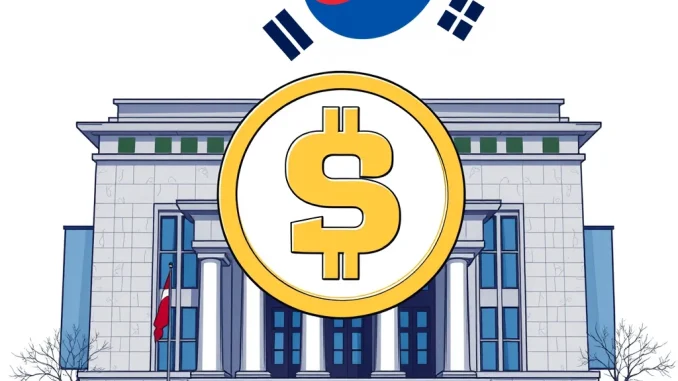
The world of cryptocurrency is constantly evolving, and with it, the need for robust regulatory frameworks becomes increasingly critical. In a recent development from South Korea, the central bank has stepped into the spotlight, urging for specific measures to govern stablecoins. But why is the Bank of Korea (BOK) so concerned, and what does this mean for the future of stablecoins and the broader crypto market? Let’s dive into the details of the BOK’s latest report and explore the pressing need for stablecoin regulations.
Why is South Korea’s Central Bank Sounding the Alarm on Stablecoins?
The Bank of Korea (BOK), the nation’s central banking institution, has recently released its 2024 payment and settlement report. Within this comprehensive document, a clear message resonated: stablecoin regulations are not just advisable, but essential for maintaining financial stability. The BOK isn’t simply making suggestions; it’s issuing a warning. They’ve highlighted potential risks associated with the widespread adoption of stablecoins, particularly if these digital currencies were to gain enough traction to rival or even replace traditional legal tender.
According to the BOK’s analysis, the unchecked proliferation of stablecoins could have significant repercussions across several key areas:
- Monetary Policy Disruption: Central banks wield monetary policy to manage inflation and economic growth. If stablecoins become a primary medium of exchange, it could undermine the central bank’s ability to control the money supply and interest rates, potentially leading to economic instability.
- Financial Instability Risks: Without proper oversight, stablecoins could pose risks to the broader financial system. Concerns range from operational failures of stablecoin issuers to inadequate reserves backing the stablecoins, which could trigger liquidity crises and contagion effects across markets.
- Payment System Vulnerabilities: While stablecoins offer the promise of faster and cheaper transactions, their unregulated use could introduce vulnerabilities into existing payment systems. Issues like settlement risks, lack of consumer protection, and potential for illicit activities need careful consideration.
The BOK’s report, as highlighted by Yonhap Infomax, underscores the urgency for a ‘separate regulatory framework’ tailored specifically for stablecoins. This isn’t about stifling innovation; it’s about proactively addressing potential systemic risks before they materialize. The central bank emphasizes its commitment to actively participate in upcoming legislative discussions, ensuring that its expert perspective is considered when shaping the future of crypto regulation.
What Exactly Are Stablecoins, and Why Do They Need Regulation?
For those new to the crypto space, stablecoins might seem like just another buzzword. However, they play a unique and increasingly important role within the cryptocurrency ecosystem. In essence, stablecoins are cryptocurrencies designed to maintain a stable value, typically pegged to a fiat currency like the US dollar or another stable asset like gold.
Here’s a simple breakdown:
| Feature | Stablecoins | Traditional Cryptocurrencies (e.g., Bitcoin, Ethereum) |
|---|---|---|
| Value Stability | Designed to maintain a stable price, often pegged 1:1 to a fiat currency. | Highly volatile, price can fluctuate significantly. |
| Purpose | Facilitate transactions, provide a stable store of value within crypto ecosystems, and bridge traditional finance with crypto. | Store of value, medium of exchange (though volatility can hinder this), and powering decentralized applications. |
| Regulation | Increasingly facing regulatory scrutiny due to potential systemic risks. | Regulatory landscape is still evolving, but generally less direct focus than stablecoins currently. |
The very feature that makes stablecoins attractive – their stability – is also what necessitates careful crypto regulation. Because they aim to be reliable and predictable in value, they have the potential for widespread adoption in payments and financial transactions. This widespread adoption, without proper safeguards, is what worries central banks like the BOK.
Financial Stability at Stake: Why South Korea is Taking a Proactive Stance
South Korea is not alone in its concerns about stablecoins. Globally, regulatory bodies are grappling with how to best approach these digital assets. However, the BOK’s explicit call for a ‘separate regulatory framework’ signals a proactive stance. Why is financial stability such a key concern in this context?
- Systemic Importance: If stablecoins become deeply integrated into the financial system, any instability in the stablecoin market could cascade and impact traditional financial institutions and markets.
- Investor Protection: Without regulations, users of stablecoins may lack adequate protection against fraud, market manipulation, and issuer failures. This is crucial for maintaining public trust in the digital asset space.
- Maintaining Monetary Sovereignty: Central banks are tasked with managing their nation’s currency and economy. The rise of privately issued stablecoins, especially those pegged to foreign currencies, could challenge this sovereignty if not managed properly.
The BOK’s move reflects a broader trend of central banks worldwide seeking to understand and manage the risks associated with digital currencies. Their active participation in legislative discussions regarding stablecoin regulations is a vital step towards creating a balanced framework that fosters innovation while safeguarding the integrity of the financial system.
The Path Forward: What Kind of Stablecoin Regulations Can We Expect?
While the specifics of South Korea’s upcoming stablecoin regulations are still to be determined through legislative discussions, we can anticipate some key areas of focus based on global trends and the BOK’s stated concerns:
- Reserve Requirements: Regulations are likely to mandate that stablecoin issuers hold adequate reserves of high-quality assets to back their stablecoins. Transparency and independent audits of these reserves will be crucial.
- Operational Standards: Expectations for robust operational frameworks for stablecoin issuers, including risk management, cybersecurity, and anti-money laundering (AML) compliance.
- Supervisory Oversight: Clear regulatory bodies will likely be designated to oversee stablecoin issuers and ensure compliance with regulations. This could involve licensing or registration requirements.
- Consumer Protection Measures: Regulations may include provisions to protect stablecoin users, such as dispute resolution mechanisms and clear disclosures about the risks associated with stablecoins.
The BOK’s active involvement in shaping these regulations is a positive sign. It suggests a commitment to creating a regulatory environment that is both prudent and supportive of responsible innovation in the cryptocurrency space. The outcome of these legislative discussions in South Korea will be closely watched by the global crypto community, as it could set a precedent for other nations grappling with similar challenges.
Looking Ahead: Navigating the Future of Crypto Regulation
The Bank of Korea’s call for stablecoin regulations is a significant moment in the ongoing evolution of cryptocurrency oversight. It highlights the growing recognition that while digital assets offer exciting opportunities, they also come with inherent risks that must be addressed proactively. For the cryptocurrency industry, this development underscores the importance of engaging with regulators and working towards frameworks that foster sustainable growth and build trust.
As South Korea moves forward with its legislative discussions, the global crypto community should pay close attention. The decisions made in Seoul could have far-reaching implications for the future of stablecoins and the broader landscape of crypto regulation worldwide. The message is clear: responsible innovation in the digital asset space requires a collaborative approach between innovators, regulators, and central banks to ensure a stable and secure financial future.



